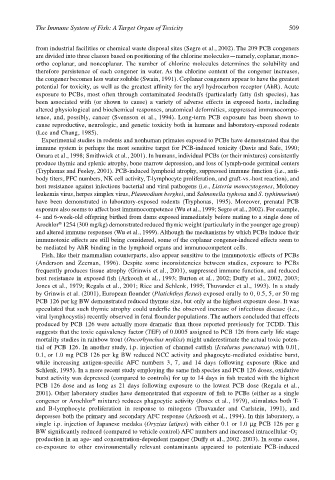Page 529 - The Toxicology of Fishes
P. 529
The Immune System of Fish: A Target Organ of Toxicity 509
from industrial facilities or chemical waste disposal sites (Segre et al., 2002). The 209 PCB congeners
are divided into three classes based on positioning of the chlorine molecules—namely, coplanar, mono-
ortho coplanar, and noncoplanar. The number of chlorine molecules determines the solubility and
therefore persistence of each congener in water. As the chlorine content of the congener increases,
the congener becomes less water soluble (Swain, 1991). Coplanar congeners appear to have the greatest
potential for toxicity, as well as the greatest affinity for the aryl hydrocarbon receptor (AhR). Acute
exposure to PCBs, most often through contaminated foodstuffs (particularly fatty fish species), has
been associated with (or shown to cause) a variety of adverse effects in exposed hosts, including
altered physiological and biochemical responses, anatomical deformities, suppressed immunocompe-
tence, and, possibly, cancer (Svensson et al., 1994). Long-term PCB exposure has been shown to
cause reproductive, neurologic, and genetic toxicity both in humans and laboratory-exposed rodents
(Lee and Chang, 1985).
Experimental studies in rodents and nonhuman primates exposed to PCBs have demonstrated that the
immune system is perhaps the most sensitive target for PCB-induced toxicity (Davis and Safe, 1990;
Omara et al., 1998; Smithwick et al., 2001). In humans, individual PCBs (or their mixtures) consistently
produce thymic and splenic atrophy, bone marrow depression, and loss of lymph-node germinal centers
(Tryphonas and Feeley, 2001). PCB-induced lymphoid atrophy, suppressed immune function (i.e., anti-
body titers, PFC numbers, NK cell activity, T-lymphocyte proliferation, and graft-vs.-host reaction), and
host resistance against infectious bacterial and viral pathogens (i.e., Listeria monocytogenes, Moloney
leukemia virus, herpes simplex virus, Plasmodium berghei, and Salmonella typhosa and S. typhimurium)
have been demonstrated in laboratory-exposed rodents (Tryphonas, 1995). Moreover, prenatal PCB
exposure also seems to affect host immunocompetence (Wu et al., 1999; Segre et al., 2002). For example,
4- and 6-week-old offspring birthed from dams exposed immediately before mating to a single dose of
®
Arochlor 1254 (300 mg/kg) demonstrated reduced thymic weight (particularly in the younger age group)
and altered immune responses (Wu et al., 1999). Although the mechanisms by which PCBs induce their
immunotoxic effects are still being considered, some of the coplanar congener-induced effects seem to
be mediated by AhR binding in the lymphoid organs and immunocompetent cells.
Fish, like their mammalian counterparts, also appear sensitive to the immunotoxic effects of PCBs
(Anderson and Zeeman, 1996). Despite some inconsistencies between studies, exposure to PCBs
frequently produces tissue atrophy (Grinwis et al., 2001), suppressed immune function, and reduced
host resistance in exposed fish (Arkoosh et al., 1993; Burton et al., 2002; Duffy et al., 2002, 2003;
Jones et al., 1979; Regala et al., 2001; Rice and Schlenk, 1995; Thuvander et al., 1993). In a study
by Grinwis et al. (2001), European flounder (Platichthys flesus) exposed orally to 0, 0.5, 5, or 50 mg
PCB 126 per kg BW demonstrated reduced thymus size, but only at the highest exposure dose. It was
speculated that such thymic atrophy could underlie the observed increase of infectious disease (i.e.,
viral lymphocystis) recently observed in feral flounder populations. The authors concluded that effects
produced by PCB 126 were actually more dramatic than those reported previously for TCDD. This
suggests that the toxic equivalency factor (TEF) of 0.0005 assigned to PCB 126 from early life stage
mortality studies in rainbow trout (Oncorhynchus mykiss) might underestimate the actual toxic poten-
tial of PCB 126. In another study, i.p. injection of channel catfish (Ictalurus punctatus) with 0.01,
0.1, or 1.0 mg PCB 126 per kg BW reduced NCC activity and phagocyte-mediated oxidative burst,
while increasing antigen-specific AFC numbers 3, 7, and 14 days following exposure (Rice and
Schlenk, 1995). In a more recent study employing the same fish species and PCB 126 doses, oxidative
burst activity was depressed (compared to controls) for up to 14 days in fish treated with the highest
PCB 126 dose and as long as 21 days following exposure to the lowest PCB dose (Regala et al.,
2001). Other laboratory studies have demonstrated that exposure of fish to PCBs (either as a single
®
congener or Arochlor mixture) reduces phagocytic activity (Jones et al., 1979), stimulates both T-
and B-lymphocyte proliferation in response to mitogens (Thuvander and Carlstein, 1991), and
depresses both the primary and secondary AFC response (Arkoosh et al., 1994). In this laboratory, a
single i.p. injection of Japanese medaka (Oryzias latipes) with either 0.1 or 1.0 µg PCB 126 per g
BW significantly reduced (compared to vehicle control) AFC numbers and increased intracellular ·O 2 –
production in an age- and concentration-dependent manner (Duffy et al., 2002. 2003). In some cases,
co-exposure to other environmentally relevant contaminants appeared to potentiate PCB-induced

